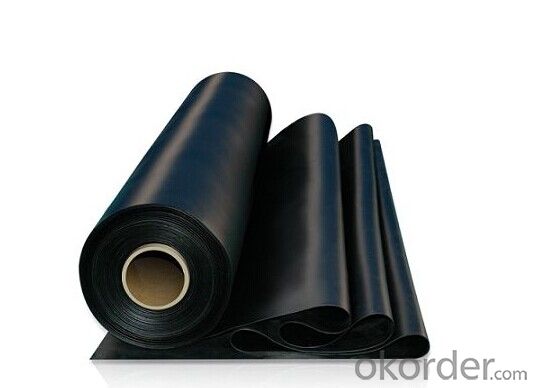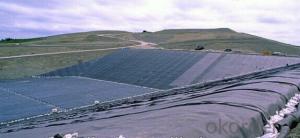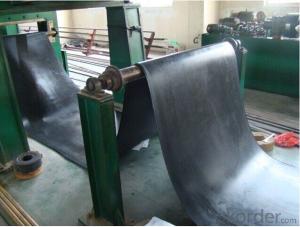EPDM Rubber Roofing Waterproof Membrane with 1.2mm/1.5mm/2.0mm
- Loading Port:
- Qingdao
- Payment Terms:
- TT OR LC
- Min Order Qty:
- 2000 m²
- Supply Capability:
- 300000 m²/month
OKorder Service Pledge
OKorder Financial Service
You Might Also Like
EPDM Waterproof Membrane
Introduction for EPDM Waterproof Membrane
EPDM waterproof membrane is of high elasticity among high polymer waterproof materials and becomes a world-popular waterproofing material.
Our EPDM waterproof membrane is made from ternary ethylene-propylene rubber, which is designed for waterproofing of exposed and non-exposed applications.
Our EPDM waterproof membrane production adopts the world-advanced equipment of cold feeding extrusion and continuous vulcanization technology.
Characteristics for EPDM Waterproof Membrane
1 Excellent physical and mechanical performance
2 High tearing resistance
3 Good deformation adaptability
4 High puncture resistance
5 High aging resistance
6 High UV resistance
Uses for EPDM Waterproof Membrane
l Roofs, Basement, Toilet
l Industrial and civil building waterproofing
l Geosynthetic liner for swimming pool, channels, irrigation system
l Especially suit for projects with high requirements in durability, anti-corrosion and deformation
Specification for EPDM Waterproof Membrane
Type | EPDM Waterproof Membrane | |||
Material | EPDM Rubber | |||
Thickness | 1.0mm | 1.2mm | 1.5mm | 2.0mm |
Size | 1.2m(width) * 20m(length)/roll | |||
Type | Vulcanized | |||
Pattern | Non-reinforced(homogeneous) | |||
Packing | 24sqm--80sqm/roll, with plastic bag | |||
Color | Black | |||
Application | Roofs, basement, pond, Lake, steel structure roof, swimming pool, underground, tunnel, etc | |||
Technical Data for EPDM Waterproof Membrane
Item | value | ||
JL1 | JF1 | ||
Tensile Strength (Mpa) | normal tamperature | 7.5 | 4.0 |
60°C ≥ | 2.3 | 0.8 | |
Elongation at break (%) | normal tamperature ≥ | 450 | 450 |
-20°C ≥ | 200 | 200 | |
Tear Resistance (N) | ≥ | 25 | 18 |
Water impermeability | 30mm | 0.3Mpa | 0.3Mpa |
Cold bending | (°C) ≤ | -40 | -30 |
Heating Shrinking rate | extand << span=""> | 2 | 2 |
shrink << span=""> | 4 | 4 | |


FAQ:
Can you produce 4m width?
Yes, no problem for us. We have four bases in China, largest one in this field.
How many quantity in one 20'' container for 1.2mm and 1.5mm?
480rolls, 11520m2 for 1.2mm and 400rolls, 9600m2 for 1.5mm
Can you provide free samples?
Yes, our samples are free, but express fees usually on buyer's account.
- Q:Can a waterproofing membrane be used for food processing facilities?
- Indeed, food processing facilities can utilize waterproofing membranes. These membranes are widely employed across various industries, including food processing, to safeguard against water intrusion and moisture-related harm. To safeguard the building structure, waterproofing membranes can be installed on floors, walls, and ceilings in food processing facilities, where maintaining cleanliness and hygiene is of paramount importance. By creating an effective barrier, waterproofing membranes effectively seal surfaces, thwarting the proliferation of mold, mildew, and bacteria that could potentially contaminate food products. Furthermore, they aid in upholding a clean and dry environment, thereby diminishing the risk of slips, falls, and accidents that could result from wet surfaces. Water-intensive processes such as cleaning, washing, and sanitizing are prevalent in food processing facilities, underscoring the need for a dependable waterproofing system. Additionally, waterproofing membranes can exhibit resistance to chemicals, oils, and other substances commonly utilized in food processing, thereby ensuring longevity and protection. It is essential to emphasize that when selecting a waterproofing membrane for a food processing facility, adherence to industry standards and regulations is imperative. The chosen membrane must be food-grade and possess certification ensuring its safety during contact with food products, thus averting any potential contamination concerns. Ultimately, the implementation of a waterproofing membrane within food processing facilities is instrumental in preserving hygienic conditions, fortifying the building structure, and securing compliance with health and safety regulations.
- Q:How to use self-adhesive waterproofing membrane?
- 4) shop self-adhesive waterproofing membrane: the self-adhesive waterproofing membrane tile in the cement waterproof mortar. The web is parallel to the adjacent web, and the joints should be made as far as possible. (When the lap mode is used, the upper surface of the lower layer is separated from the upper surface of the membrane and the upper surface of the upper membrane is removed and then overlapped. 5) beat the surface of the membrane, mention pulp: with a wooden trowel or rubber plate tapping the surface of the coil, mention pulp, discharge the membrane under the surface of the air, so that the membrane and cement mortar close fit. 6) to put on: dry for 24 hours to 48 hours (depending on the specific time depending on the ambient temperature, under normal circumstances, the higher the temperature the shorter the time required).
- Q:Can waterproofing membranes be used on concrete surfaces?
- Yes, waterproofing membranes can be used on concrete surfaces. These membranes are specifically designed to provide a protective barrier against water penetration and can be applied to concrete to prevent water damage and leakage.
- Q:Can a waterproofing membrane be used in conjunction with fire protection systems?
- Yes, a waterproofing membrane can be used in conjunction with fire protection systems. While the primary function of a waterproofing membrane is to prevent water penetration, it can also act as a barrier to protect against fire. Some waterproofing membranes have fire-resistant properties, allowing them to withstand high temperatures and prevent the spread of fire. However, it is essential to ensure that the specific waterproofing membrane chosen is compatible and approved for use with the fire protection system in question.
- Q:Are waterproofing membranes suitable for residential basements?
- Residential basements can indeed benefit from the use of waterproofing membranes. These membranes are specifically engineered to avert water infiltration and safeguard the basement against any harm caused by moisture. Whether applied on the interior or exterior walls, they create a formidable barrier against both water and dampness. This, in turn, helps to stave off problems like mold growth, water damage, and structural decay. With their excellent durability and ability to foster a dry and wholesome living space, waterproofing membranes emerge as a highly effective solution for residential basements.
- Q:Can a waterproofing membrane be used in rooftop gardens or green roofs?
- Yes, a waterproofing membrane can be used in rooftop gardens or green roofs. In fact, it is essential to have a reliable waterproofing system in place to protect the structure beneath the garden or roof from water damage. A waterproofing membrane acts as a barrier, preventing water from seeping into the building or causing structural issues. It is typically installed beneath the soil or growing medium of the rooftop garden or green roof, ensuring that water is properly drained and doesn't compromise the integrity of the building. Additionally, these membranes are designed to withstand the exposure to UV rays, temperature fluctuations, and root penetration, making them suitable for long-term use in rooftop gardens or green roofs.
- Q:Can a waterproofing membrane be used on concrete block walls?
- Yes, a waterproofing membrane can be used on concrete block walls. Concrete block walls are susceptible to water penetration, which can lead to issues such as mold, mildew, and structural damage. A waterproofing membrane is a protective barrier that is applied to the surface of the concrete block walls to prevent water from seeping through. It acts as a barrier against moisture, creating a watertight seal and preventing water from entering the interior of the walls. This helps to maintain the integrity of the walls and protect against water-related damages. However, it is important to ensure that the waterproofing membrane is properly installed and that any existing cracks or gaps in the concrete block walls are adequately sealed before applying the membrane.
- Q:Can a waterproofing membrane be used on precast steel surfaces?
- Yes, a waterproofing membrane can be used on precast steel surfaces. Waterproofing membranes are designed to provide a protective barrier against water infiltration, and they can be applied to a variety of surfaces, including precast steel. The membrane acts as a waterproof layer, preventing water from penetrating the surface and causing damage. It is important to ensure that the surface is properly prepared and cleaned before applying the membrane to ensure proper adhesion and effectiveness. Additionally, it is recommended to consult with a professional waterproofing contractor to determine the best type of membrane and application method for the specific precast steel surface.
- Q:Can a waterproofing membrane be used on tunnels with subway systems?
- Tunnels with subway systems can indeed benefit from the use of a waterproofing membrane. It is strongly advised to incorporate this protective layer into subway tunnel construction to prevent water infiltration and potential harm to the structure and electrical systems. The waterproofing membrane acts as a barrier, effectively excluding water and safeguarding the tunnel against issues caused by moisture, such as corrosion, mold, and deterioration. It is crucial to select a waterproofing membrane that is specially designed for tunnel use and capable of withstanding the unique challenges and conditions of subway systems, including heavy traffic loads, vibrations, and exposure to chemicals. Moreover, it is essential to ensure the installation of the waterproofing membrane is carried out by experienced professionals who adhere to the appropriate guidelines and specifications, guaranteeing its effectiveness and durability.
- Q:Are waterproofing membranes resistant to diesel fuel?
- Typically, diesel fuel is not resisted by waterproofing membranes. Being a petroleum-based substance, diesel fuel can harm various types of waterproofing materials. The membrane's integrity can be degraded, reducing its ability to prevent water from penetrating. Consequently, it is crucial to avoid exposing waterproofing membranes to diesel fuel since it can compromise their effectiveness and durability. If there is a chance of diesel fuel coming into contact with the membrane, it is advisable to employ extra protective measures like chemical-resistant barriers or a secondary containment system to avert any potential harm to the waterproofing membrane.
1. Manufacturer Overview |
|
|---|---|
| Location | |
| Year Established | |
| Annual Output Value | |
| Main Markets | |
| Company Certifications | |
2. Manufacturer Certificates |
|
|---|---|
| a) Certification Name | |
| Range | |
| Reference | |
| Validity Period | |
3. Manufacturer Capability |
|
|---|---|
| a)Trade Capacity | |
| Nearest Port | |
| Export Percentage | |
| No.of Employees in Trade Department | |
| Language Spoken: | |
| b)Factory Information | |
| Factory Size: | |
| No. of Production Lines | |
| Contract Manufacturing | |
| Product Price Range | |
Send your message to us
EPDM Rubber Roofing Waterproof Membrane with 1.2mm/1.5mm/2.0mm
- Loading Port:
- Qingdao
- Payment Terms:
- TT OR LC
- Min Order Qty:
- 2000 m²
- Supply Capability:
- 300000 m²/month
OKorder Service Pledge
OKorder Financial Service
Similar products
New products
Hot products
Related keywords



























